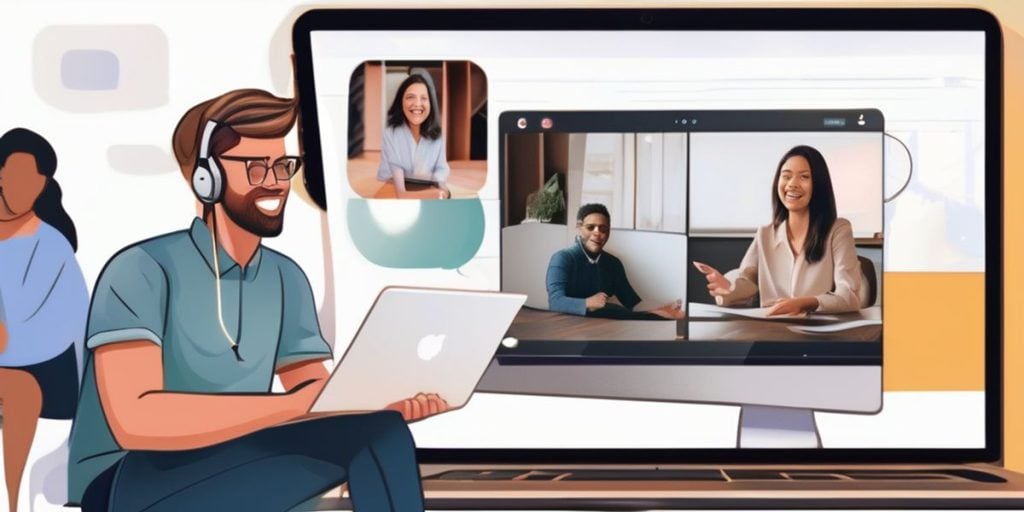In the evolving landscape of remote work, developing extraordinary talent and keeping employees engaged are critical for organizational success. This article explores various strategies to create a supportive and stimulating remote work environment. By implementing these practices, managers and leaders can not only attract and retain top talent but also foster a culture of innovation, collaboration, and well-being that drives business success.
Key Takeaways for Fostering a Positive Remote Work Culture
Cultivate trust and autonomy to reduce micromanagement and empower employees, enhancing their engagement and productivity.
Build a connected community through team-building activities and informal interactions, mitigating the isolation of remote work.
Regular one-on-ones and open feedback channels are essential for clear communication and ensuring employees feel heard and valued.
Offer clear career progression and learning opportunities to motivate employees and encourage their professional growth.
Prioritize well-being with initiatives supporting work-life balance and mental health to maintain a healthy and engaged workforce.
Cultivating a Culture of Trust and Autonomy

Avoiding Micromanagement
To foster a culture of trust, it’s crucial to avoid micromanagement. Trust your remote employees to manage their tasks and time effectively. Encourage them to work in a way that suits them best, as long as they meet their goals and complete their work on time. Establish a framework promoting individual accountability, using tools like SMART goals, OKRs, and KPIs to provide clear expectations and autonomy.
Empowering Employee Decision-Making
Empower your employees by involving them in decision-making processes. Recognize their contributions and give them the autonomy to implement new ideas and provide feedback on initiatives. This not only enhances their sense of ownership but also contributes to the company culture in a meaningful way.
Recognizing Contributions
Regularly acknowledge and celebrate your employees’ achievements. Effective recognition and reward programs are instrumental in driving business outcomes, especially during challenging times. Personal recognition awards can help maintain high levels of engagement and motivation, building a sense of belonging and community among remote teams.
By focusing on feedback and listening, you create a continuous loop where employees discuss progress and receive constructive guidance, reinforcing a culture centered around trust and empowerment.
Build trust in remote teams by developing a natural sense of connection and community.
Inspire with employee recognition award ideas that enhance engagement through personal acknowledgment.
Drive business success with recognition programs that are effective even in a recession.
Fostering Connection and Community

Organizing Team-Building Activities
To foster team bonding and a sense of belonging, consider organizing regular virtual team-building activities. These can range from simple ice-breaker sessions to more elaborate online escape rooms or trivia contests. The key is to make these activities inclusive and enjoyable for all team members.
Ice-breaker sessions
Online escape rooms
Trivia contests
Facilitating Informal Virtual Interactions
Encourage your team to engage in informal conversations about non-work topics. This helps to create a sense of community and can be facilitated through virtual coffee breaks or ‘water cooler’ chat rooms. These interactions are crucial for building relationships and trust within the team.
Virtual coffee breaks
‘Water cooler’ chat rooms
Encouraging Peer-to-Peer Recognition
Implementing a system where team members can recognize each other’s contributions can significantly boost morale and engagement. This could be through a simple ‘kudos’ channel on your communication platform or a more structured peer recognition program.
‘Kudos’ channel
Structured peer recognition program
By prioritizing these strategies, you can help your remote employees feel more connected and engaged, which is essential for maintaining a productive and positive work environment.
Enhancing Communication and Feedback

Conducting Regular One-on-Ones
Regular one-on-one meetings are a cornerstone of effective communication. They provide a private space for you to discuss progress, address concerns, and set goals. Ensure these sessions are consistent and focused on personal development as well as business outcomes. Here’s how to make the most of them:
Schedule them at a frequency that suits both you and your employee.
Prepare an agenda to keep the conversation on track.
Use this time to give and receive feedback.
Providing Constructive Feedback
Feedback is a powerful tool for growth when delivered constructively. It should be specific, actionable, and focused on behavior rather than personal attributes. Remember, the goal is to guide your employees towards better performance and not to criticize them. To provide effective feedback:
Be timely in your response to both positive and negative behavior.
Focus on the situation, not the person.
Encourage a two-way dialogue.
Implementing Open Channels for Suggestions
Encouraging your team to voice their ideas and concerns openly can lead to valuable insights and innovations. Leverage technology to create an environment where feedback is welcomed and accessible. Here are some steps to consider:
Set up an online suggestion box or forum.
Regularly review and acknowledge the contributions.
Act on viable suggestions to show that you value their input.
By fostering an environment where communication is transparent and feedback is a part of the culture, you’re not only enhancing engagement but also building a stronger, more cohesive team.
Offering Professional Growth Opportunities

Creating Clear Career Pathways
To keep your remote employees engaged and motivated, it’s essential to create clear career pathways. This involves outlining potential career trajectories within the company and providing a roadmap for advancement. By doing so, you give your team members a sense of direction and purpose, which is crucial for long-term engagement.
Define job roles and responsibilities
Set achievable milestones and promotion criteria
Offer mentorship programs to guide employees
Providing Learning and Development Resources
The availability of learning and development resources is a key factor in fostering employee growth. Encourage your team to participate in training and development programs, online courses, or coaching sessions. This not only enhances their skills but also demonstrates your investment in their professional future.
Type of Resource | Examples |
|---|---|
Online Courses | Udemy, Coursera |
Webinars | Industry-specific seminars |
Coaching | Personalized one-on-one sessions |
Encouraging Innovation and Idea Sharing
Fostering an environment where innovation and idea sharing are encouraged can lead to extraordinary talent development. Create platforms for your team to propose new projects or improvements, and ensure that these contributions are recognized and potentially implemented.
Implement suggestion boxes or digital forums
Organize regular brainstorming sessions
Celebrate and reward innovative ideas
Encouraging your remote employees to grow professionally is not just about providing resources; it’s about creating an ecosystem where they can thrive and feel valued.
Prioritizing Employee Well-Being

Ensuring the holistic well-being of your remote employees is crucial for their productivity and overall satisfaction. Here are some strategies to consider:
Avoiding Micromanagement
Have routine remote one-on-ones to address individual concerns.
Educate employees about work/life balance and encourage them to set boundaries.
Empowering Employee Decision-Making
Offer support and encouragement when challenges arise.
Create opportunities for informal non-work conversations to foster community.
Recognizing Contributions
Send personalized thank-you messages or e-cards for birthdays and accomplishments.
Provide gifts, bonuses, or public recognition to acknowledge exceptional performance.
To truly prioritize employee well-being, consider offering a catalog of ergonomic home-office equipment and partner with wellness apps like WellBeats, Calm, and Headspace.
Remember, solutions that support preventive health and managing all aspects of well-being are key to reducing healthcare spending and maintaining work-life boundaries in a remote work environment.
Implementing Recognition and Reward Systems

Celebrating Milestones and Achievements
Recognizing the significant milestones and achievements of your team is crucial for maintaining motivation and a sense of progress. Create a culture of celebration by marking important dates and accomplishments. Here’s how you can do it:
Establish a calendar of company-wide milestones
Encourage teams to share their successes
Publicize achievements through internal channels
Personalizing Rewards
Personalized rewards show that you value your employees as individuals. Tailor rewards to match their preferences and interests for a more meaningful impact. Consider these points:
Get to know your employees’ likes and dislikes
Offer a variety of reward options
Allow employees to choose their own rewards
Utilizing Technology for Recognition Programs
Leverage modern technology to streamline and enhance your recognition programs. Use platforms that integrate with your existing tools and make recognition a seamless part of the workday. Here’s a quick overview:
Platform | Integration Options | User-Friendly Rating |
|---|---|---|
Bonusly | Slack, Microsoft Teams | 5/5 |
Recognize | Salesforce, Workplace | 4/5 |
Kudos | Zoom, Google Workspace | 4.5/5 |
Ensure that your recognition programs are accessible, equitable, and distributed fairly to make every employee feel heard and valued.
Leveraging Technology to Enhance Engagement

Adopting Collaborative Tools
You know that feeling of being in the same room with your team, even when you’re miles apart? That’s the power of collaborative tools. They’re not just about sharing documents; they’re about creating a space where ideas can flow freely. Embrace platforms that offer real-time editing, video conferencing, and instant messaging to keep the team connected and the creativity buzzing.
Real-time editing: Google Docs, Microsoft Office 365
Video conferencing: Zoom, Microsoft Teams
Instant messaging: Slack, Microsoft Teams
Utilizing Engagement Platforms
Engagement platforms are your secret weapon for keeping remote employees invested in their work and the company culture. These platforms can offer recognition, rewards, and a sense of community that might otherwise be lost in a remote setting. Look for features like employee recognition tools, milestone celebrations, and voice of employee feedback mechanisms.
Feature | Example Platforms |
|---|---|
Employee Recognition | Achievers, Bonusly |
Milestone Celebrations | Workstars, Kudos |
Feedback Mechanisms | Officevibe, Culture Amp |
Incorporating Gamification Strategies
Gamification isn’t just for fun and games; it’s a strategic way to boost engagement and motivation. By turning work-related tasks into a game with points, badges, and leaderboards, you can spark a healthy sense of competition and achievement among your team. Remember, the goal is to encourage participation and reward performance in a way that aligns with your company values.
Points for project milestones
Badges for skill achievements
Leaderboards for friendly competition
By leveraging technology effectively, you can create an engaging and dynamic remote work environment that not only retains talent but helps them thrive.
Conclusion
In conclusion, developing extraordinary talent and keeping remote employees engaged requires a multifaceted approach that goes beyond traditional management techniques. Leaders must embrace trust and autonomy, recognize contributions, and foster a culture of connection and well-being. By implementing strategies such as routine one-on-ones, informal conversations, and team-building initiatives, managers can combat the sense of isolation and nurture a thriving remote work environment. Remember, engagement starts with understanding each employee’s passion and commitment, and it is sustained by continuous recognition and opportunities for growth. As we adapt to the new digital workforce, let’s commit to creating positive workspaces where remote employees feel valued, connected, and motivated to contribute to the company’s success.
Frequently Asked Questions
How can managers foster trust and avoid micromanagement with remote employees?
Managers can foster trust by setting clear expectations and providing the necessary resources for employees to meet those expectations. Avoid micromanagement by focusing on outcomes rather than processes, and trust employees to manage their workflow effectively.
What are some effective team-building activities for remote teams?
Effective team-building activities for remote teams include virtual escape rooms, online game nights, collaborative challenges, and virtual coffee breaks or happy hours to encourage informal interactions and strengthen team bonds.
How should feedback be provided to remote employees?
Feedback should be timely, specific, and constructive. Regular one-on-one video calls can be used to provide personalized feedback and discuss any concerns or areas for improvement in a supportive manner.
What professional growth opportunities can be offered to remote employees?
Companies can offer remote employees access to online courses, webinars, and virtual conferences. Additionally, creating clear career pathways and encouraging mentorship programs can help employees see a future within the organization.
How can remote employee well-being be prioritized by companies?
Companies can support remote employee well-being by offering flexible work schedules, resources for mental health support, and virtual wellness programs that promote physical health and social interaction.
What are some innovative ways to recognize and reward remote employees?
Recognition can be personalized through shoutouts in virtual meetings, digital rewards, or company-wide emails. Utilizing technology like recognition platforms can make celebrating achievements more interactive and fun, such as through gamification strategies.
